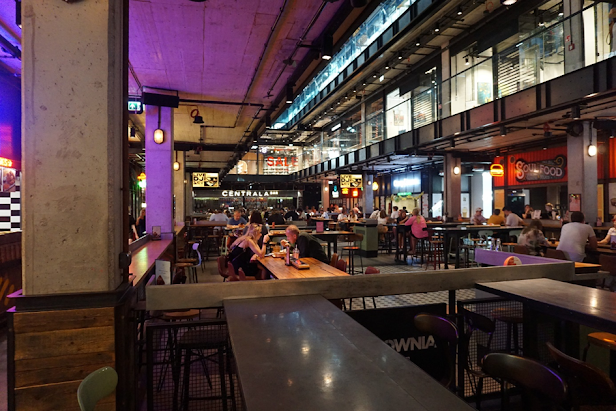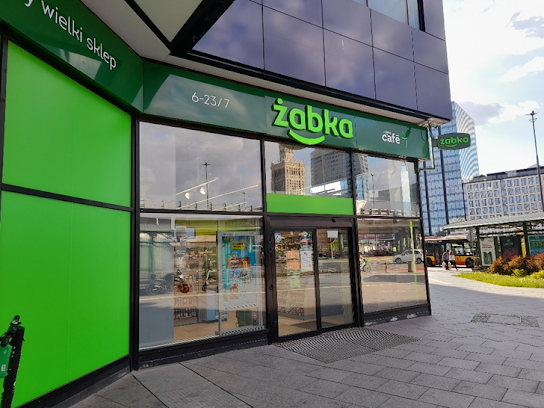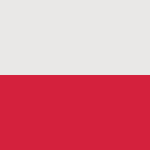Eat and get drunk in Warsaw
#Warsaw tour guide #Warsaw city guide # guided tour in warsaw #Warszawa tour guide #Warszawa city guide #guided tour in Warszawa
The restaurant scene is dynamic – they come and go!
When I made my first Warsaw guide 10 years ago, I included a long list of bars and restaurants. However, this turned out to be an unfortunate decision, as the restaurant scene in Warsaw is dynamic. Many close every year, others reopen, and the quality and focus changes all the time. In this guide, I mention when there are recommendable places nearby, but this is as it stands in the summer of 2024, so it can easily change. I also make a point of pointing out areas where you can get something to eat and drink.
In a group or alone – many bar owners like you to sit by a table
Poles tend to go out in groups, and in many places you’ll be seated at a table and expected to talk to the acquaintances you’ve brought with you. This is obviously not conducive to making acquaintances with strangers, but by late evening (especially on weekends), many of the bars in the city centre will be so crowded that people are standing close together and there is always an opportunity for communication. And many bars have also learnt that a bar counter is conducive to communication between guests, but it’s still not at tradition to sit at the bar in Poland. In many places, the counter is blocked by the waiters’ tools and you are forced to sit at a table.
Michelin *** Warsaw is not a star-city yet, but it is on the way
Warsaw currently has only one Michelin-starred restaurant, but typing “Warsaw Michelin restaurant” into Google brings up 19 restaurants, all of which have a current recommendation from this authoritative food guide. I’ve gone through the list, know most of the restaurants, and can recommend the ones I know (and the rest I’ve heard good things about) with the addition that the price is about half of what it would be at a similar French restaurant.
The culinary evolution
Many tourists consider delicious food an essential part of travelling, and Warsaw has developed dramatically in the last 10-20 years. Immigrants from all over the world have arrived and left their mark on the city’s restaurants, and Polish chefs have travelled and worked in the rest of Europe. In short, there has been a huge culinary exchange in recent years. Unfortunately, there are also a number of restaurants that have closed down as a result of the Corona pandemic.
Fat is out, green and imports from Europe is in!
Many tourists consider delicious food an essential part of travelling, and Warsaw has developed dramatically in the last 10-20 years. Immigrants from all over the world have arrived and left their mark on the city’s restaurants, and Polish chefs have travelled and worked in the rest of Europe. In short, there has been a huge culinary exchange in recent years. Unfortunately, there are also a number of restaurants that have closed down as a result of the Corona pandemic.
McDonalds, Pizza restaurants and kebab is everywhere
Sometimes you just need something to eat, and here you’ll find McDonald’s, Burger King and pizza restaurants everywhere.
Milk bars (bar mleczny) – the old style communist canteen has been modernised
The contrast to Michelin are the milk bars. This was traditionally the way Poles ate when they were away from home. In recent years, they’ve undergone a huge quality upgrade, and in the centre of Warsaw, there’s usually a menu in English as well. In the outlying neighbourhoods, they’re sometimes less spruced up and it can be difficult for a non-Polish-speaking tourist to navigate the offerings.
Lawyers, students and old age pensioners all go to the milk bar
Milk bars are frequented by all kinds of people and often cater for the elderly and disabled. The dishes are typically Polish and you point to the side dishes if you don’t understand the menu. The turnover is huge, so the food is definitely fresh all the time and usually tasty too. In any case, a visit to a milk bar is part of the cultural enrichment of a visit to Poland. They don’t serve alcohol, but if you’re tired of Coca-Cola, you can have a glass of compote (fruit juice), which is usually served in glasses at the counter.
Learn hov to order and clean up after yourself
You order and pay at a cash register, get your food at a counter, and when you’re done, you leave your tray and leftovers on a rack.
Enjoy nature with a beer and a Polish sausage
If you want to enjoy cold beer and hearty food in harmony with nature, a few places mentioned under “Forests and parks in Warsaw” include the Cultural Park in Powsin and Pole Mokotowskie.
Grilling is a national Polish sport
In summer, Poles grill, and of course they do so in outdoor restaurants – parks and all outdoor drinking spots are the perfect place to cool off in the heat. Sausages are taken seriously in Poland, so they are usually made with care.
Food halls – you find them everywhere
At the section with metro station, you’ll find mentions of food halls. Here are just a few of the best:
Elektrownia Powiśle, ul. Dobra 42. Metro Centrum Nauki Kopernika.
Hala Koszyki, ul. Koszyki 61/63. Metro Politechnika.
Mala Mirowska, Plac Żelaznej Bramy 1. Metro ONZ.
Konoser (former industrial area, more open area than actual hall), Plac Konesera 1-10. Metro Dworzec Wieleński.
Soho Factory (former industrial area, more open space than actual hall), Mińska 25.

Food hall Elektrownia
Chain restaurants
Chain restaurants have made their entrance – a long time ago. Chains like McDonald’s, Burger King, Pizza Hut and KFC are heavily represented in the city and require no introduction. Starbucks and Subway probably don’t either. You’ll also find a number of local pizza, kebab and burger chains, all of which have become experts in door-to-door delivery using bike messengers.

American fast food culture is firmly rooted in Warsaw
Jeff’s is American-inspired cuisine with lots of calories
Żabka is the Polish equivalent of 7-Eleven and can be found everywhere. Here you can get beer, vodka and other essentials when other shops are closed. They also sell hot dogs and coffee at reasonable prices

Żabka (the little frog) is Poland’s answer to 7-Eleven
Sphinx was founded in 1995, serves fast food at tables and tries to pass itself off as an actual restaurant.
Pijalnia Wódka i piwo (Drinking Place Vodka and Beer) and Ministerstwo Śledzia i Wódki (Ministry of Herring and Vodka) are local bars with light dishes that refer to Polish traditions. They are inexpensive and without special new-fangled sales methods. You pick up the goods at the bar counter. A great place if you simply want to drink and chat.

Pijalnia Wódka i piwo (vodka and beer) – if you want to keep it simple and cheap
There are also a number of cafés, of which Caffè Nero seems to be everywhere. They don’t serve beer or alcohol, but do have sandwiches and huge cakes.
Wedel is a chocolate factory in Warsaw that has chocolate cafés all over Poland.

The Wedel chocolate factory in Warsaw. In the old custom house in front of the factory is a café with chocolate and light lunch dishes.
Have you been inspired by the above, or is it too generalised? As I said, I don’t dare make a detailed food and drink guide, but let me mention a few areas worth checking out.
Poznanska Street – just opposite the Palace of Culture
A long street dominated by refurbished buildings from before World War 2. It runs parallel to Marszałkowska Street.
Both the street itself and the neighbouring side streets are packed with bars and restaurants of all kinds. It’s a street that is predominantly frequented by locals and the quality is good in most places. Prices are generally reasonable, but there are a few higher-end places, so check the menu, which is usually posted outside.
If you start from the Palace of Culture and Hotel Polonia Palace, you’ll first encounter an elegant restaurant (Żebra i kości = ribs and bones) and a gritty restaurant in a somewhat lower price range. On the way, you’ll pass Italian food, ice cream parlours, pastries and small cafés, while there’s a cool local vibe at the other end of the street, including Beirut and Kraken Rum bar, located right across from Tel Aviv, which you can frequent if you’re dreaming of vegan kosher or just want to enjoy an Israeli lager.
Nowogrodzka Street – strip, cheap bars and craft beer
It’s a long street, but we start from inside the shadow of the Palace of Culture and turn down Marszałkowska Street, then turn left on Nowogrodzka by the tall Hotel Novotel.
If you’re a man, you might be offered a free strip show in the area by a charming young lady, but unless you’re looking to empty your bank account, you should probably move on. These clubs can be quite aggressive and are regularly featured in the newspapers for various scams.
Once you get a little further down the street, however, you’ll be met with a glorious array of bars with reasonably priced craft beers, and if you’re looking for something even cheaper, pop into Pijalnia Wódka i piwo (Vodka and Beer Drinking Place). There are also a few excellent and unpretentious restaurants in the street.
Plac konstytucji – a few big restaurants
(Constitution Square) – The square with Stalin’s prestigious buildings – Here you’ll find a number of large restaurants and bars, which are also geared to cater for larger groups (large groups require careful consideration, otherwise you risk sitting for hours waiting for your food).
Plac Zbawiciela – this is where you want to be, if you like to party!
(Our Saviour’s Square, after a large church located on the square) – a few hundred metres from Plac konstytucji.
A relatively small circular square filled with small bars, each with its own profile. This is where a large part of Warsaw’s youth spend their evenings or nights. A few of the bars are legendary, so I’ll take my chances and bet they won’t be closing anytime soon: Coffee Karma from 2002, one of the places that started the coffee craze; Charlotte – a French-style bakery serving light meals; Plan B on the first floor – open late into the night and on Christmas Eve. A perfect place if you like to drink and mingle with other people. And then there are all the other places on the square.
The White House – drink beer and feel like a communist!
Another great place is the (beer) bars at the White House on Rondo de Gaulle – right next to the National Museum on Aleje Jerozolimskie. This is where serious communist bureaucrats sat until 1989, today the courtyard and neighbourhood is filled with happy beer-drinking people.

Currently, five bars cater for thirsty guests in the old Communist Party headquarters
Nowy Świat – Towards Old Town. Foksal Street has an intensive night life
From the White House you can walk towards the old town through Nowy Świat, where you’ll also find a vibrant nightlife, especially if you head down the side streets. Of the side streets, I would particularly recommend Chmielna, which runs all the way down to the Palace of Culture, and Foksal Street, which is simply the place to go, if you like an intensive night life.
Furthermore, you can creep in through the gate at Nowy Świat no. 26 and end up in a large backyard with lots of small pubs.

Through the gate at Nowy Świat 26
Sąska Kępa – the elegant area
On the other side of the river is the Praga district. Here, especially the exclusive Sąska Kępa is full of great bars and restaurants, much of it centred around Francuska Street.
Praga – tourists aren’t banned, they just haven’t discovered it yet
The Praga area around Metro Wieleński, like Sąska Kępa, belongs to the “less posh” side of the river, but it is gradually overcoming old prejudices. While Sąska Kępa is relatively exclusive, the atmosphere around Metro Wieleński is local. If you walk down from the metro to Jagielloński Street, you’ll find a number of cosy and excellent restaurants, while a walk down Ząbkowska Street leads you past a huge amount of small, creatively decorated pubs where locals chat about life’s big and small questions. Continuing 5-10 minutes out of Ząbkowska brings you to the Konoser vodka museum and lifestyle area.
Plac Grzybowski – exploring the Jewish past
Between Grzybowski Square and Marszałkowska Street – close to the Świętokrzyska metro – you’ll find the only street in the Jewish ghetto that wasn’t destroyed in 1943, Próżna Street. Both here and in the square itself, a number of cafés and restaurants have sprung up, some of which reference Warsaw’s Jewish past.
The Old Town
The Old Town is, of course, full of restaurants and bars. Most of them are also excellent and the prices are reasonable. But … you should be aware that locals rarely go to the Old Town to eat. This means that the menu and quality is geared towards tourists. I’ve had far worse tourist food in different parts of the world than what’s on offer in Warsaw’s Old Town, but you shouldn’t expect top cuisine. On the other hand, the atmosphere is cosy and the Rynek itself often hosts events, making it a great place to sit and enjoy life.

Eating and drinking in Poland
A small story about food in Poland and how it has developed in recent decades. What can you buy in Poland and what do Poles eat. The food culture, when to eat and when to say no thanks. Includes some practical expressions if you’re travelling to Poland and want to know what some of the popular things are called in Polish.
Please send an email to m@hardenfelt.pl if you would like an English-speaking tour guide to show you the most important places in Warsaw.

